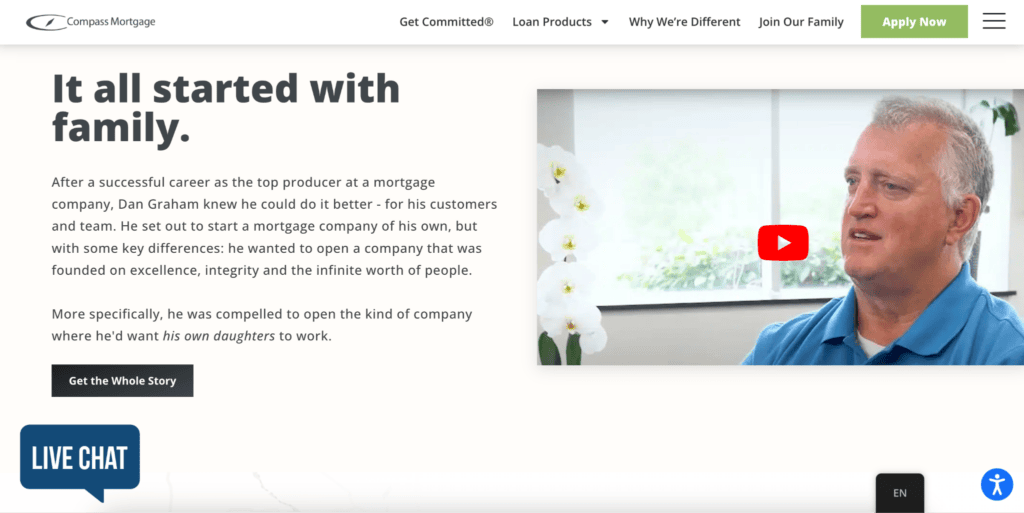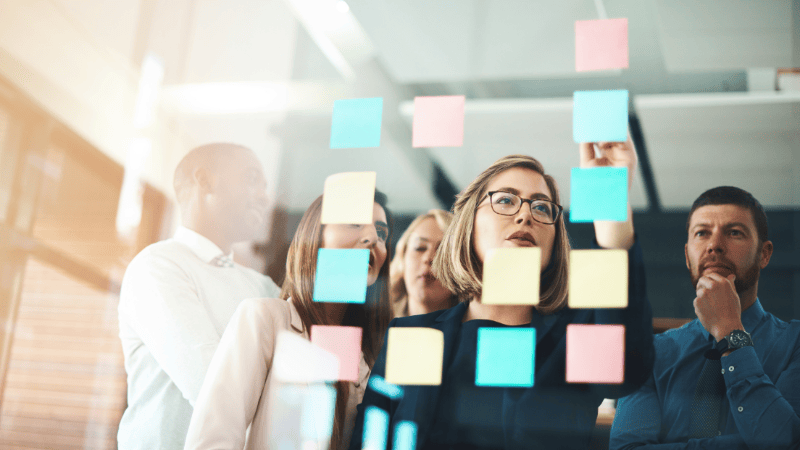Digital mortgage marketing campaigns seem easy on the surface: Write some articles for your website, post on Facebook once a day, and upload a video to YouTube here and there.
However, more and more mortgage companies are now competing for attention in the same space as you are—vying for the same audience.
As a result, distinguishing your brand becomes the key to attracting and retaining clients.
This is where storytelling comes in.
In this article, we’ll explore why storytelling matters in your mortgage marketing campaigns and how to effectively craft, share, and measure the impact of your story through mortgage content marketing.
Why storytelling matters in mortgage marketing campaigns
Stories grab audiences’ attention much more than conventional sales pitches or data-heavy presentations.
Instead of simply listing the benefits of a mortgage loan, a company could share a story about a young couple who were able to buy their dream home thanks to a tailored mortgage plan.
This type of story engages clients by portraying scenarios they can envision themselves in, making the abstract elements of mortgage products tangible through real-life contexts.
The psychological impact of storytelling on decision-making
Emotional responses to stories can form stronger memories and personal connections.
For a mortgage client, a story that creates feelings of security, happiness, or aspiration linked to owning a home can steer decisions toward seeking similar outcomes.
This emotional connection is crucial in the mortgage industry, where trust and reliability are key factors in choosing a lender.
Components of effective storytelling in marketing
To captivate and engage readers, a story must have three fundamental elements: character, conflict, and resolution.
- Character: In mortgage marketing stories, the characters are typically the clients or companies. For example, a character could be a first-time homebuyer navigating the complexities of mortgages or a family looking to refinance their home to save money.
- Conflict: Conflict introduces the main problem or challenges that the characters must overcome. In mortgage marketing, the conflict could be the struggle to find a trustworthy lender, the complexity of mortgage terms, or the challenge of securing financing in a tough economic climate.
- Resolution: The resolution provides a satisfying conclusion to the story, revealing how the characters overcome their challenges with the help of the mortgage company’s products or services.
Tailoring stories to resonate with homebuyers and investors
To effectively reach and influence their prospects, mortgage companies need to define character, conflict, and resolution within the context of their audience.
This means:
- Developing characters that represent your diverse clientele (customer personas)
- Identifying the most pressing concerns or fears that your clients face
- Offering resolutions that share the unique benefits of your services, such as customized mortgage options or fast and easy application processes
- Highlighting how these solutions specifically address the conflicts
Including real client testimonials or case studies as part of the resolution adds credibility and genuine proof of success.
Successful storytelling in mortgage marketing campaigns
To inspire your storytelling, let’s take a look at some examples.
It all started with family
Compass Mortgage leverages the story of its own beginnings to express to its audience what makes it different and how this helps it get a mortgage.

The company highlights the story on its home page, with links to a “Why We’re Different” landing page that shares its mission and core values and a YouTube video with the company CEO.
Disrupting the concept of investing
Marquee Funding Group directly addresses its audience’s pain points and explores tailored solutions in an inspiring visual journey through the company’s firm and surrounding areas.

Both companies choose scenarios that mirror the actual experiences and challenges of their target audiences.
This relevance makes the stories compelling and persuasive, as potential clients could see themselves in the narratives and envision achieving similar successful outcomes.
How to craft your mortgage story
Crafting an effective mortgage story involves careful planning and deeply understanding your audience’s needs.
The steps to building your lender narrative include:
- Defining your audience
- Choosing your key message
- Selecting a story format
- Developing characters
- Outlining the conflict
- Crafting the resolution
- Closing with a strong conclusion
How to incorporate real-life stories
Your client testimonials and success stories are the most impactful and relevant to your target audience.
Look for stories illustrating clear before-and-after scenarios where your services made a significant difference.
Enhance the testimonials with photos, videos, or audio recordings whenever possible. Multimedia elements make the stories more engaging and help bring the testimonials to life.
Integrating storytelling across different marketing channels
Spreading your storytelling across various marketing channels expands your reach and reinforces your brand’s message.
Consider the following formats for your stories:
- Blogs: Blog posts allow for detailed storytelling with the flexibility to integrate multimedia elements like images, links, and videos
- Videos: Create video testimonials, story-driven advertisements, and behind-the-scenes stories about your clients or your company
- Newsletters: Incorporate storytelling by regularly featuring client stories, updates on previous stories, and new services or products framed within narrative contexts
- Social media: Tailor your stories to fit the platform, such as sharing short client story snippets on X (Twitter) and longer success stories on Facebook
- Webinars and live streams: These formats are excellent for detailed explanations of complex processes, live Q&A to cover doubts in real time, and direct engagement with your community
Multi-channel storytelling will widen your reach across all audiences and reinforce your messaging and brand identity.
It also opens the door for various forms of feedback, engagement with your audience, and the ability to leverage each platform’s analytic tools.
Measuring the impact of storytelling in mortgage content marketing
Are your stories resonating with your audience?
Track your website traffic, engagement metrics, and conversion metrics to ensure that your mortgage content marketing efforts are having an impact.
If you’re not getting the desired results, try A/B testing with two versions of your story (different headers, photos, etc.) and measure which one performs better.
You also can directly ask your audience for feedback through surveys or feedback forms.
Challenges and considerations for mortgage marketing campaigns
Don’t fall into these challenges with your storytelling efforts:
- Lack of authenticity
- Exaggerating the truth
- Overly complex
- Not segmenting your audience
- Underestimating your story’s impact
- Inconsistent messaging
Always be transparent about the nature of the stories you share.
While stories can powerfully influence decisions, they should never manipulate or mislead the audience.
Unlock better storytelling
Mortgage content marketing isn’t just about targeted marketing techniques meant to get in front of your potential audience.
Kaleidico’s content creation process is built from a holistic, human-centered philosophy — consumers find what they’re looking for, and you gain business from engaged and qualified leads.
We can help you construct a smooth and compelling path to your loan products that works as a powerful lead generation system.
Mortgage marketing campaigns FAQ
To advertise your mortgage business effectively, use a mix of digital marketing strategies, including SEO-optimized content, social media marketing, email campaigns, and pay-per-click advertising.
Emphasize customer testimonials and success stories to build trust and credibility.
The best place to advertise mortgages is online, where you can reach a broad audience.
Focus on platforms like Google through search engine ads, social media platforms like Facebook and LinkedIn for targeted ads, and real estate websites where potential homebuyers and investors frequent.
To generate more leads as a mortgage broker, invest in building a strong online presence, engage with local real estate groups, and leverage referral programs.
Enhance your website’s user experience, optimize it for conversions, and keep engaging with past clients to encourage referrals.

